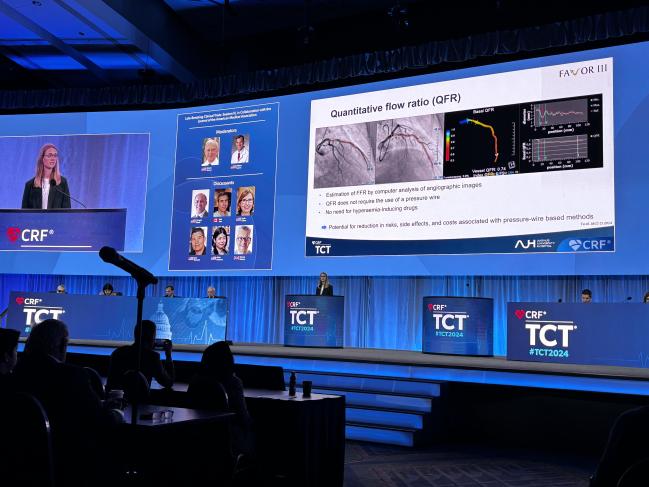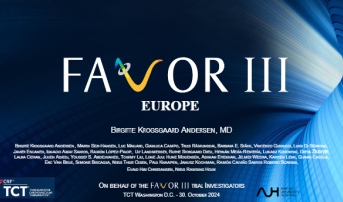QFR No Match for FFR in Guiding Revascularizations: FAVOR III Europe
The inability of QFR to rival FFR for 1-year MACE is a reminder of the need for large studies, even when new tech is enticing.

WASHINGTON, DC—As a guide for deciding whether to revascularize patients with intermediate coronary stenoses, quantitative flow ratio (QFR) isn’t able to match fractional flow reserve (FFR) in terms of 12-month clinical outcomes, data from the large, randomized, FAVOR III Europe trial show.
The findings call into question current guidelines for functional assessment, said Birgitte Krogsgaard Andersen, MD (Aarhus University Hospital, Denmark), who presented FAVOR III Europe here at TCT 2024. QFR was recently granted a class I, level of evidence B, indication in the 2024 European Society of Cardiology (ESC) guidelines for chronic coronary syndromes.
FFR, on the other hand, has long had a class I, level of evidence A, indication in both European and US guidelines. Despite this, “the adoption of FFR remains low,” said Andersen. “The main reasons are physician self-belief in angiographic diagnosis, questionable long-term clinical value, reimbursement systems not supporting the use of FFR, and patient risks and discomfort.” Moreover, as reported by TCTMD, data from FLOWER-MI and other negative trials have raised questions about FFR’s utility.
QFR is a wireless, angiography-based approach that uses computer software to estimate FFR, whereas conventional FFR uses a pressure wire under adenosine-induced hyperemia to measure coronary flow. Without the need for a wire or adenosine, QFR has the potential to reduce risks and side effects for patients as well as the cost, Andersen added.
The results caught many off guard at TCT 2024. Early results for QFR were favorable, as were data from the FAVOR III China study showing an advantage for preprocedural QFR over angiographic guidance alone.
The proof of the pudding is in the eating. Joost Daemen
Joost Daemen, MD, PhD (Erasmus University Medical Center, Rotterdam, the Netherlands), speaking in a press conference, described FAVOR III Europe as a “highly anticipated trial with also an unanticipated outcome.”
QFR is a technology “that has been hyped over the past 5 to 10 years, with multiple validation studies by different funders, different core labs across the globe showing very consistent findings in terms of the diagnostic accuracy of this technology,” Daemen commented.
It goes to show, he said, that “at the end, the proof of the pudding is in the eating.” FAVOR III Europe is the first large trial to test QFR in such a rigorous way, “and we find it is just not as good,” said Daemen. “That attests to the importance of trials like this . . . but also showed the vulnerability of the guidelines.”
FAVOR III Europe
FAVOR III Europe enrolled 2,000 patients (median age 67.3 years; 76.9% male) with chronic coronary syndromes or stabilized acute coronary syndromes at 34 centers across 11 European countries. All had at least one intermediate nonculprit lesion (40-90% diameter stenosis by visual estimate). Two-thirds presented with chronic coronary syndromes, a quarter for secondary evaluation following ACS, and around 8% with NSTEMI.
The participants, after being stratified by diabetes status and location of nonculprit lesion were randomized to either angiography-derived QFR (Medis Medical Imaging) or pressure wire-based FFR assessment. With both methods, the cutoff for functional significance justifying revascularization was ≤ 0.80: the median QFR value was 0.81 and the median FFR value was 0.84.
“The lower QFR values led to 21% more patients receiving study lesion revascularization [and] a 27% increase in the number of stents implanted in these lesions,” Andersen reported. Revascularization was performed in the culprit lesion for 45.8% of the FFR group and 54.4% of the QFR group (P = 0.0001), with a total of 650 stents with FFR and 823 stents with QFR. “Furthermore, the location of the significant lesions differed between the two groups,” with the QFR picking up more lesions than FFR in the circumflex artery, she noted.
While procedure times and contrast volume were similar between the two strategies, the FFR arm had a longer fluoroscopy time (median 11.0 vs 9.3 min; P = 0.0001).
In each group, 1.8% of patients had an adverse procedural event, most often procedure-related MI (1.0% with QFR and 0.7% with FFR). One patient assigned to QFR guidance had an index procedure-related death.
Median follow-up was 365 days. The primary endpoint of MACE—death, MI, or unplanned revascularization at 12 months—occurred in 6.7% of QFR patients and 4.2% of FFR patients (HR 1.63; 95% CI 1.11-2.41). This 2.5% difference (90% two-sided CI 0.9%-4.2%) did not meet the prespecified noninferiority margin of 3.4%.
The disparity in MACE rate between the two groups was mainly driven by MIs (2.0% with FFR and 3.7% with QFR; HR 1.84; 95% CI 1.07-3.17). Unplanned revascularization also trended lower with FFR, but the difference wasn’t statistically significant (2.5% vs 3.3%; HR 1.36; 95% CI 0.81-2.30).
FAVOR III Europe “indicates that, although angiography-based functional lesion evaluation is promising, further development might be required to reach the established level of clinical value achieved with FFR,” the investigators conclude.
This, paired with FAVOR III China showing QFR to be superior to angiography, suggests “the current QFR method might be positioned between angiography and FFR in terms of diagnostic clinical value,” they say. “With the findings of FAVOR III Europe, QFR might not be a reasonable alternative to FFR when FFR is available.”
Discussant Mamas Mamas, BMBCh, DPhil (Keele University/Royal Stoke University Hospital, Stoke-on-Trent, England), pointed to several noteworthy aspects of FAVOR III Europe. First, he said, the study required operators to have experience with at least 30 QFR cases and to submit 15 cases to the core lab for feedback, so lack of training cannot explain the results.
The imbalance in QFR versus FFR values is unusual, added Mamas, though with more stents implanted and more patients revascularized, it makes sense there would be more stent-related events in the QFR group. He also drew attention to the trial’s open-label design, noting that “there’s clearly [room for] bias, particularly for ischemia testing, which is one of the factors that drove the differences in outcomes.”
“What’s driving these events?” Mamas said. “Is it the false-positive revascularization or the deferral of negatives?” Three percent of all lesions in FAVOR III Europe, he noted, were not treated in line with the FFR and QFR results, and there was wide variation in outcomes across countries.
It’s not just about how it was used, but also the software itself. Niels Ramsing Holm
Niels Ramsing Holm, MD (Aarhus University Hospital), senior author of FAVOR III Europe, told TCTMD that there are two reasons to explain why QFR didn’t match FFR in their trial: interobserver variability and the software.
Data have suggested both intra- and interobserver variation can be issues when using QFR, he explained. “With more complex lesions, we start to see the bigger variation. So this could have led to the worse result.”
There also may be a need to fine-tune the computer software that analyzes the angiographic images at the basis of QFR, Holm added. “It’s not just about how it was used, but also the software itself.”
Mamas, in his discussion, also raised that possibility. “One has to be concerned whether it’s a technology problem,” he said, “or whether this is a problem with operators using this technology.”
For now, Mamas advised, pressure wire-based indices should be the gold standard, with the newer options being used only in the context of trials.
What’s driving these events? Is it the false-positive revascularization or the deferral of negatives? Mamas Mamas
Holm said it’s not yet known whether there’s a class effect that extends beyond QFR to other novel technologies being developed for wire-free physiological testing. Ongoing trials, such as FAST III, PIONEER-IV, and ALL-RISE, might provide answers, he added.
Daemen agreed that whether the outcomes of QFR extend to other platforms “is something we have to learn.” His gut feeling had been that “these indices would perform more or less identically,” he noted, though “there are no proper head-to-head comparisons at the moment.”
The answer as to which approach is best “will come down not just to the diagnostic accuracy of the technology in the core lab but also to how easily these technologies are applied—and how accurately they can be applied—online at 2 PM in the afternoon or 3 AM in the morning,” Daemen stressed. “That is, I think, something that may arise from the competing trials with different platforms.”
Until then, he said, the field needs to be careful in applying these tools in daily practice.
Clyde Yancy, MD (Northwestern University Feinberg School of Medicine, Chicago, IL), speaking with the media, emphasized, “This is exactly why we do randomized trials, particularly for strategy interventions.” Even when the science or concept seems appealing, he explained, “it has to be tested in a rigorous way.”
Caitlin E. Cox is News Editor of TCTMD and Associate Director, Editorial Content at the Cardiovascular Research Foundation. She produces the…
Read Full BioSources
Andersen BK, Sejr-Hansen M, Maillard L, et al. Quantitative flow ratio versus fractional flow reserve for coronary revascularisation guidance (FAVOR III Europe): a multicentre, randomised, non-inferiority trial. Lancet. 2024;Epub ahead of print.
Disclosures
- The study was funded by Medis Medical Imaging.
- Andersen reports grant/research support from Medis Medical Imaging.
- Holm reports institutional research grants from Abbott, B. Braun, Biosensors, Boston Scientific, and Medis Medical Imaging plus speaker fees from Abbott and EPS.
- Mamas reports grant/research support from Abbott and Medtronic as well as consultant/honoraria/speaker fees from Terumo Medical, Daiichi Sankyo/Eli Lilly and Company, and Biosensors.
- Daemen reports grant support/research contracts from Boston Scientific, ACIST, Medtronic, Pie Medical, and Recor Medical as well as consulting fees/honoraria/speaking fees from ACIST, Boston Scientific, Recor Medical, Pie Medical, Medtronic, and PulseCath BV.
- Yancy reports no relevant conflicts of interest.




Comments